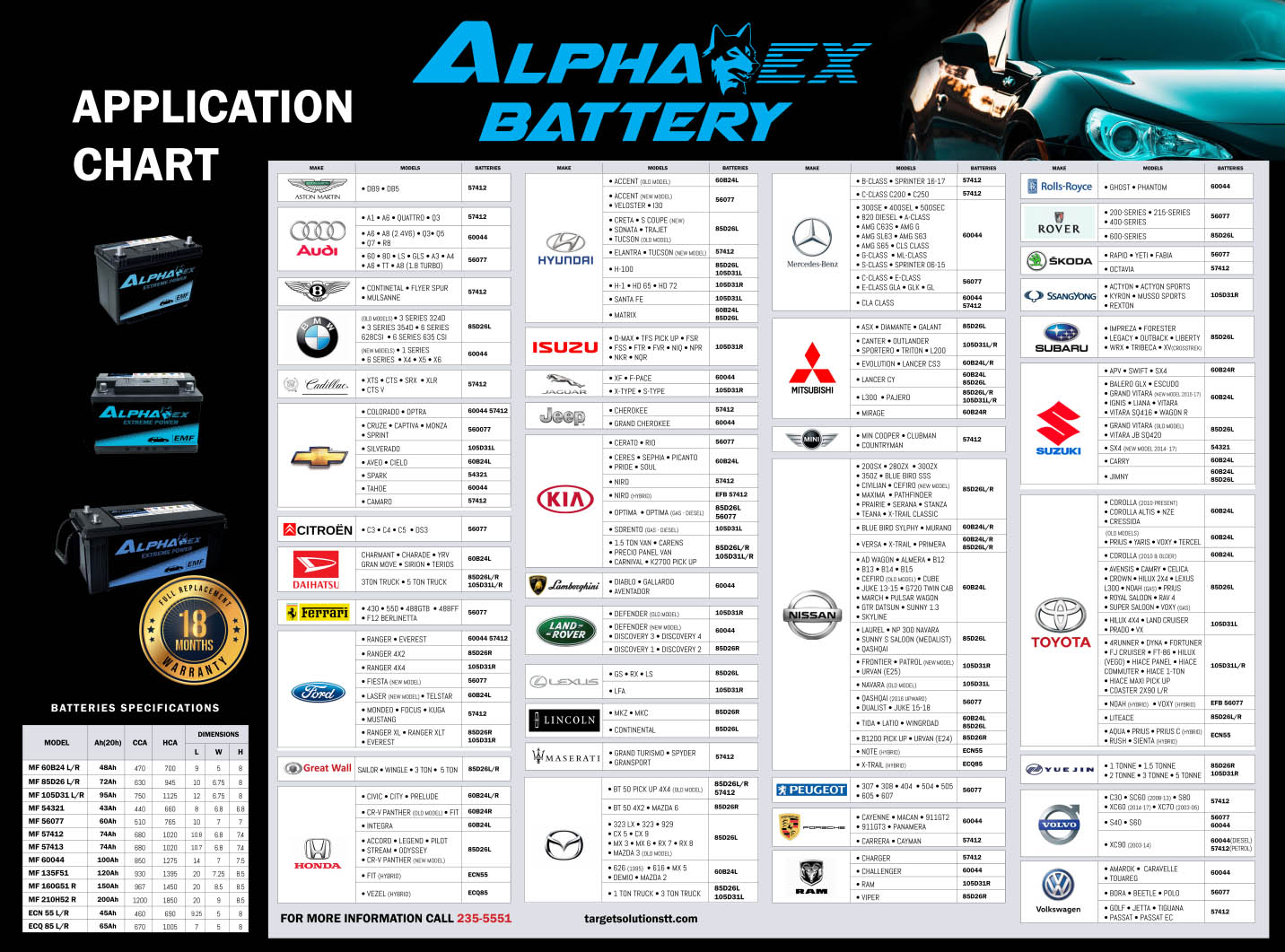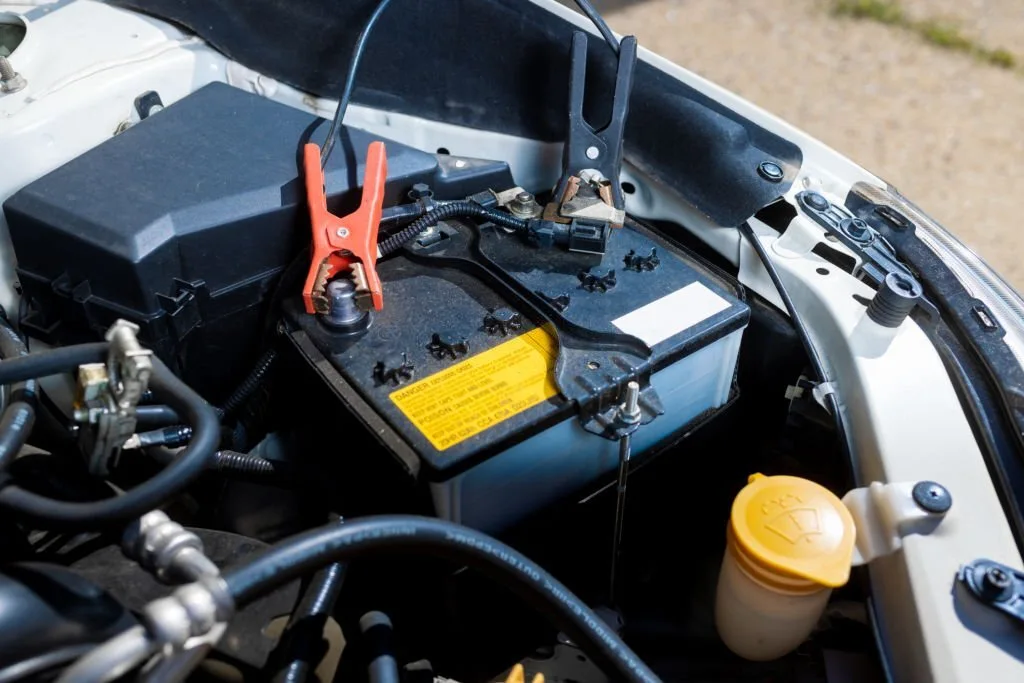Are you facing the frustrating dilemma of a car that just won’t start? Or perhaps you’re proactive and want to ensure that your vehicle runs smoothly in the future.
Either way, choosing the right battery for your car is crucial. It’s not just about getting your car to start; it’s about ensuring reliability and performance every time you turn the key. With so many options and technical terms out there, the decision can feel overwhelming.
But don’t worry. In this guide, you’ll find clear, easy-to-understand information to help you pick the perfect battery. Imagine the peace of mind you’ll have, knowing your car is powered by the right choice. Read on to discover how you can make an informed decision and avoid those dreaded moments when your car won’t start.

Credit: www.targetsolutionstt.com
Types Of Car Batteries
The lead-acid battery is very common. It is used in many cars. They are affordable and reliable. But they are heavy. They also need regular maintenance. Water levels must be checked often. These batteries work well in normal temperatures.
AGM batteries are better than lead-acid. They do not spill. They need less care. These batteries are durable and last longer. They can handle cold weather well. But they are more expensive. Many new cars use AGM batteries.
Lithium-ion batteries are the newest type. They are very light and powerful. These batteries charge quickly. They also last a long time. But they cost a lot. Electric cars use lithium-ion batteries. They are good for the environment.
Understanding Battery Specifications
Cold Cranking Amps (CCA) is very important for a car battery. It shows how well the battery works in cold weather. A higher CCA means the battery can start the car even when it’s freezing. This is crucial if you live in a cold area. Always check the CCA before buying a battery.
Reserve Capacity tells you how long the battery can run when the car’s alternator fails. It’s measured in minutes. A battery with a high Reserve Capacity can keep your car’s lights and radio on longer. It’s a good idea to choose a battery with a higher Reserve Capacity for extra safety.
Group Size is about the battery’s physical size. It ensures the battery fits in your car’s battery tray. Always check your car’s manual for the right Group Size. This way, you won’t have trouble installing the new battery. Picking the right size is simple but important.
Factors To Consider
Cold weather can affect battery performance. Car batteries often struggle in low temperatures. In hot climates, batteries may wear out faster. Extreme heat can cause battery fluid to evaporate. It’s important to choose a battery designed for your climate. Consider the temperature your car faces most often.
Short trips can drain a battery quickly. Frequent stops need more power. Long drives help keep the battery charged. If you don’t drive often, a battery tender might help. It’s a device that keeps your battery charged. Think about your daily drive and choose accordingly.
Every car has specific needs. Check your car manual for battery size and type. Some cars need more power for electronics. Features like heated seats or GPS might need a stronger battery. Always match the battery to your car’s needs. Using the right battery ensures your car runs smoothly.

Credit: www.swbatteries.com.au
Maintenance And Care
Check the car battery often. Look for any leaks or cracks. Make sure there are no loose connections. This helps the battery last longer.
Dirt on the terminals can cause problems. Use a brush to clean them. A mix of baking soda and water works well. Rinse with water and dry.
A car battery needs a full charge. Short trips can drain it fast. Go for longer drives sometimes. If the battery gets weak, charge it soon. A charger can help at home.
Signs Of A Failing Battery
The engine takes longer to start. This is called a slow crank. It means the battery may be weak. A healthy battery starts the engine quickly. If it doesn’t, it may need checking.
Car lights look dim at night. This can be a sign. The battery is not giving enough power. Dim lights can make it hard to see. It can also make driving unsafe.
The check engine light comes on. This light warns of car problems. A failing battery can trigger it. If the light is on, get the battery checked. It can save from future trouble.

Credit: www.jiffylube.com
How To Choose The Right Battery
Choose a battery that matches your car’s needs. Check the battery size and power. Your car manual will have these details. A wrong size won’t fit or work well. Check the battery’s voltage and capacity. This ensures your car starts easily.
Choose a trusted brand for long-lasting use. Brands with a good reputation make reliable batteries. Also, check the warranty offered. A good warranty ensures you are covered if the battery fails. Longer warranties are better.
Batteries have different prices. Some are cheap, others cost more. Balance between cost and quality is important. Cheap batteries may not last long. Higher quality batteries may save money over time. Set a budget and find a battery within that range.
Installation And Disposal
Choosing the right car battery involves understanding installation and disposal processes. Proper installation ensures longevity, while correct disposal protects the environment. Always follow guidelines for safe handling.
Safe Removal Of Old Battery
Always wear gloves and goggles for safety. Ensure the car is off and the keys are out. First, remove the negative cable. Next, take off the positive cable. Lift the battery carefully. It can be heavy. Put it in a safe place.
Proper Installation Techniques
Clean the battery tray before installing a new battery. Place the new battery in the tray. Connect the positive cable first. Then, attach the negative cable. Tighten all connections well. Check for a secure fit. Start the car to ensure it works.
Environmentally Friendly Disposal
Take the old battery to a recycling center. Never throw it in the trash. Batteries contain chemicals that can harm nature. Some stores may offer disposal services. They ensure safe and correct handling. Always choose a green disposal method.
Frequently Asked Questions
How Do I Choose The Right Car Battery?
Check your car’s manual for battery specifications. Consider size, power needs, and climate conditions.
What Is The Average Lifespan Of A Car Battery?
Car batteries typically last 3 to 5 years. Regular maintenance can extend their lifespan.
Why Does My Car Battery Keep Dying?
Frequent short trips, extreme temperatures, or electrical issues can drain your battery. Check for these problems.
Conclusion
Choosing the right battery keeps your car running smoothly. Consider your driving habits and climate. Check your vehicle’s manual for guidance. Understand the different battery types available. Maintenance requirements matter too. Opt for a battery with a good warranty. A reliable battery ensures fewer breakdowns.
Consult a professional if unsure. Remember, a good battery saves time and money. Regular checks prevent unexpected failures. Make informed decisions for your car’s longevity. Protect your investment with the right battery choice. Stay safe and enjoy the drive!